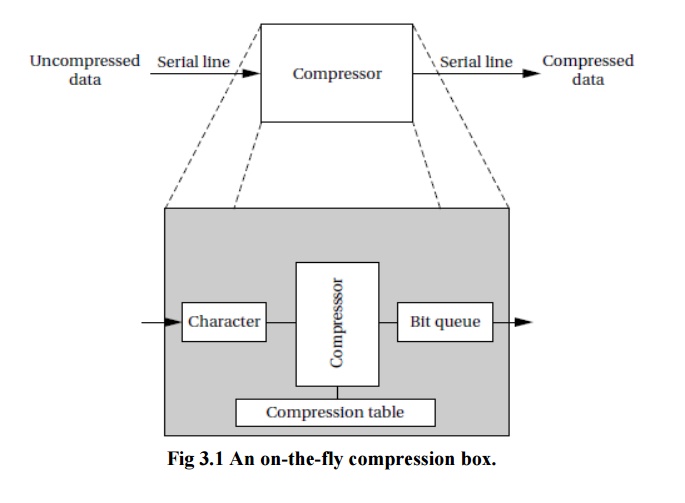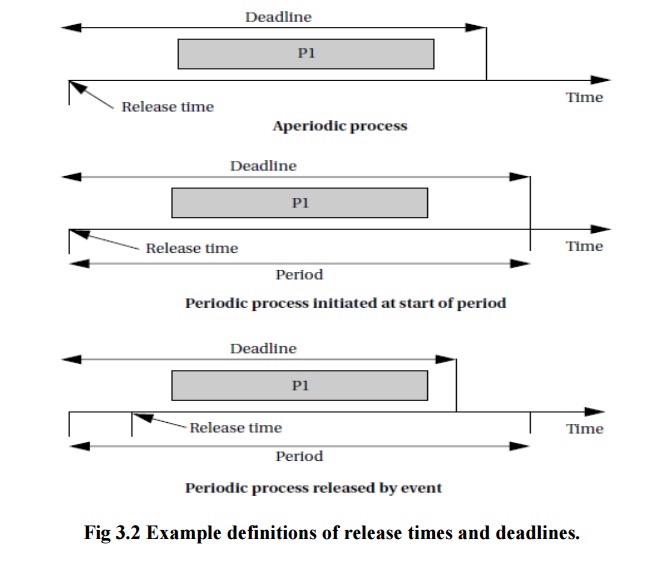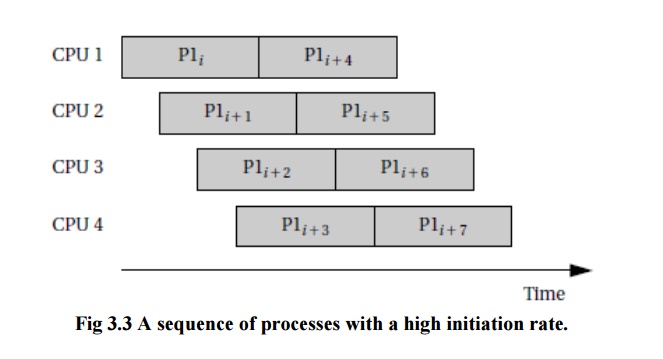Chapter: Embedded and Real Time Systems : Process and Operating Systems
Multiple Tasks and Multiple Processes
MULTIPLE
TASKS AND MULTIPLE PROCESSES:
Tasks and Processes
Many (if
not most) embedded computing systems do more than one thing that is, the
environment can cause mode changes that in turn cause the embedded system to
behave quite differently. For example, when designing a telephone answering
machine,
We can
define recording a phone call and operating the user’s control panel as
distinct tasks, because they perform logically distinct operations and they
must be performed at very different rates. These different tasks are part of the system’s functionality, but that application-level
organization of functionality is often reflected in the structure of the
program as well.
A process
is a single execution of a program. If we run the same program two different
times, we have created two different processes. Each process has its own state
that includes not only its registers but all of its memory. In some OSs, the
memory management unit is used to keep each process in a separate address
space. In others, particularly lightweight RTOSs, the processes run in the same
address space. Processes that share the same address space are often called threads.
As shown
in Figure 3.1, this device is connected to serial ports on both ends. The input
to the box is an uncompressed stream of bytes. The box emits a compressed
string of bits on the output serial line, based on a predefined compression
table. Such a box may be used, for example, to compress data being sent to a
modem.
The
program’s need to receive and send data at different rates for example, the
program may emit 2 bits for the first byte and then 7 bits for the second byte
will obviously find itself reflected in the structure of the code. It is easy
to create irregular, ungainly code to solve this problem; a more elegant
solution is to create a queue of output bits, with those bits being removed
from the queue and sent to the serial port in 8-bit sets.

But
beyond the need to create a clean data structure that simplifies the control
structure of the code, we must also ensure that we process the inputs and outputs
at the proper rates. For example, if we spend too much time in packaging and
emitting output characters, we may drop an input character. Solving timing
problems is a more challenging problem.
The text
compression box provides a simple example of rate control problems. A control
panel on a machine provides an example of a different type of rate control
problem, the asynchronous input.
The
control panel of the compression box may, for example, include a compression
mode button that disables or enables compression, so that the input text is
passed through unchanged when compression is disabled. We certainly do not know
when the user will push the compression mode button the button may be depressed
asynchronously relative to the arrival of characters for compression.
Multirate Systems
Implementing
code that satisfies timing requirements is even more complex when multiple
rates of computation must be handled. Multirate embedded computing systems
are very common, including automobile engines, printers, and cell phones. In
all these systems, certain operations must be executed periodically, and each
operation is executed at its own rate.
Timing Requirements on Processes
Processes
can have several different types of timing requirements imposed on them by the
application. The timing requirements on a set of processes strongly influence
the type of scheduling that is appropriate. A scheduling policy must define the
timing requirements that it uses to determine whether a schedule is valid.
Before studying scheduling proper, we outline the types of process timing
requirements that are useful in embedded system design.
Figure
3.2 illustrates different ways in which we can define two important
requirements on processes: release time and deadline.
The
release time is the time at which the process becomes ready to execute; this is
not necessarily the time at which it actually takes control of the CPU and
starts to run. An aperiodic process is by definition initiated by an event,
such as external data arriving or data computed by another process.
The
release time is generally measured from that event, although the system may
want to make the process ready at some interval after the event itself. For a
periodically executed process, there are two common possibilities.
In
simpler systems, the process may become ready at the beginning of the period.
More sophisticated systems, such as those with data dependencies between
processes, may set the release time at the arrival time of certain data, at a
time after the start of the period.
A
deadline specifies when a computation must be finished. The deadline for an
aperiodic process is generally measured from the release time, since that is
the only reasonable time reference. The deadline for a periodic process may in
general occur at some time other than the end of the period.
Rate
requirements are also fairly common. A rate requirement specifies how quickly
processes must be initiated.
The period
of a process is the time between successive executions. For example, the period
of a digital filter is defined by the time interval between successive input
samples.
The
process’s rate is the inverse of its period. In a multirate system, each
process executes at its own distinct rate.

The most
common case for periodic processes is for the initiation interval to be equal
to the period. However, pipelined execution of processes allows the initiation
interval to be less than the period. Figure 3.3 illustrates process execution
in a system with four CPUs.

CPU Metrics
We also
need some terminology to describe how the process actually executes. The initiation
time
is the time at which a process actually starts executing on the CPU.
The
completion time is the time at which the process finishes
its work.
The most
basic measure of work is the amount of CPU time expended by a process. The
CPU time of process i is called Ci . Note that the CPU time is not equal
to the completion time minus initiation time; several other processes may
interrupt execution. The total CPU time consumed by a set of processes is
|
T= ∑ Ti |
(3.1) |
We need a
basic measure of the efficiency with which we use the CPU. The simplest and
most direct measure is utilization:
|
U=CPU time for useful work/total
available CPU time |
(3.2) |
Utilization
is the ratio of the CPU time that is being used for useful computations to the
total available CPU time. This ratio ranges between 0 and 1, with 1 meaning
that all of the available CPU time is being used for system purposes. The
utilization is often expressed as a percentage. If we measure the total
execution time of all processes over an interval of time t, then the CPU utilization is
|
U=T/t. |
(3.3) |
Related Topics